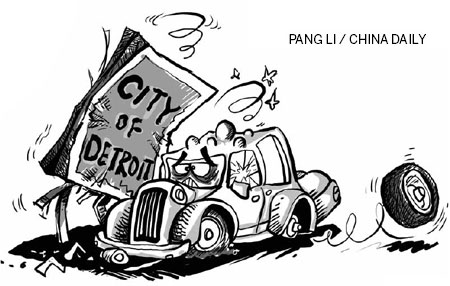Beware of the Detroit syndrome
Updated: 2013-07-30 09:41
By Sanjeev Sanyal (China Daily)
|
|||||||||||

When the city of Detroit filed for bankruptcy, it became the largest such filing in United States history. Detroit's population has dropped from 1.8 million in 1950, when it was America's fifth-largest city, to less than 700,000 today. Its industrial base lies shattered.
And yet we live in a world where cities have never had it so good. More than half of the world's population is urban for the first time in history, and urban hubs generate an estimated 80 percent of global GDP. These proportions will rise even higher as emerging market economies urbanize rapidly. So, what can the world learn from Detroit's plight?
As recently as the 1990s, many experts were suggesting that technology would make cities irrelevant. It was believed that the Internet and mobile communications, then infant technologies, would make it unnecessary for people to live in crowded and expensive urban hubs. Instead, cities like New York and London have experienced sharp increases in population since 1990, after decades of decline.
One factor that has helped cities is the nature of 21st century life. Previously, life in developed countries was based on daily routines: people went to work in offices and factories, returned home to eat dinner with their families, watched their favorite television programs, went to sleep, and repeated the cycle all over again the next day.
Such regular cycles no longer apply to most peoples' lives. In the course of a work day, people mix and match many activities - they may work at a desk, but they may also meet a friend for lunch, go to the gym, do chores, travel on business, shop online and so on.
Similarly, time at home is no longer clearly demarcated, with people working online or participating in conference calls even as they manage their family life. We have discovered that this multi-tasking life is best done in cities, which concentrate a multiplicity of hard amenities - airports, shops, schools, parks, and sports facilities - as well as soft amenities like clubs, bars and restaurants.
Another factor is that cities have increased in importance as hubs for innovation and creativity. Until the 19th century, innovation was carried out mostly by generalists and tinkerers, which meant that the accumulation of new knowledge was slow, but its diffusion across different fields was rapid. In the 20th century, knowledge creation became the job of specialists, which accelerated innovation but retarded inter-disciplinary application.
Related Stories
China's cities should learn from Detroit's bankruptcy 2013-07-23 19:19
Detroit suffers from US political system 2013-07-29 20:21
Detroit: A magnet for China's auto industry 2013-07-26 12:23
Detroit: Gold mine for China 2013-07-30 08:11
Today's Top News
FM welcomes deal with EU on solar panel dispute
Major SOEs eye profits from abroad
Train collision injures dozens in Switzerland
7-year-old 'brain dead' after swimming lesson
Families of crash victims to sue Asiana in the US
Open investigations urged after killings
Families looking to adopt turn to website
Sino-Japanese summit ruled out
Hot Topics
Lunar probe , China growth forecasts, Emission rules get tougher, China seen through 'colored lens', International board,
Editor's Picks

|

|

|

|

|

|





